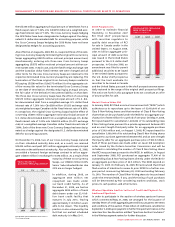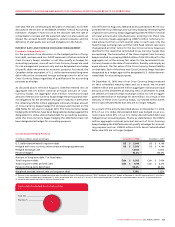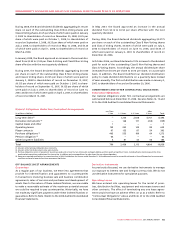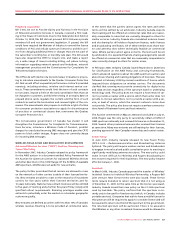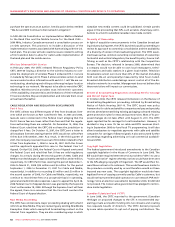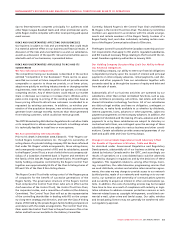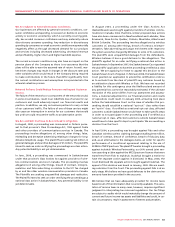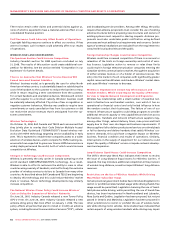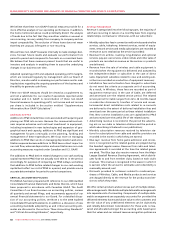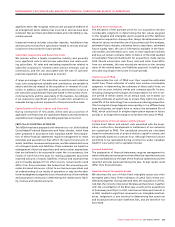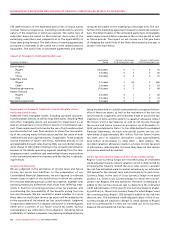Rogers 2008 Annual Report Download - page 65
Download and view the complete annual report
Please find page 65 of the 2008 Rogers annual report below. You can navigate through the pages in the report by either clicking on the pages listed below, or by using the keyword search tool below to find specific information within the annual report.
ROGERS COMMUNICATIONS INC. 2008 ANNUAL REPORT 61
MANAGEMENT’S DISCUSSION AND ANALYSIS OF FINANCIAL CONDITION AND RESULTS OF OPERATIONS
Sports Entertainment competes principally for audiences with
other Major League Baseball teams and other professional sports,
while Rogers Centre competes with other local sporting and special
event venues.
RISKS AND UNCERTAINTIES AFFECTING OUR BUSINESSES
Our business is subject to risks and uncertainties that could result
in a material adverse effect on our business and financial results. A
discussion of the risks and uncertainties to us and our subsidiaries,
as well as a discussion of the specific risks and uncertainties associ-
ated with each of our businesses, is presented below.
RISKS AND UNCERTAINTIES APPLICABLE TO RCI AND ITS
SUBSIDIARIES
We Face Substantial Competition.
The competition facing our businesses is described in the section
entitled “Competition In Our Businesses”. There can be no assur-
ance that our current or future competitors will not provide services
comparable or superior to those we provide, or at lower prices,
adapt more quickly to evolving industry trends or changing market
requirements, enter the market in which we operate, or introduce
competing services. Any of these factors could reduce our market
share or decrease our revenue or increase churn. Wireless antici-
pates some ongoing re-pricing of the existing subscriber base as
lower pricing offered to attract new customers is extended to or
requested by existing customers. In addition, as wireless pen-
etration of the population deepens, new wireless customers may
generate lower average monthly revenues than those generated
from existing customers, which could slow revenue growth.
The CRTC Broadcasting Distribution Regulations do not allow Cable
or its competitors to obtain exclusive contracts in buildings where
it is technically feasible to install two or more systems.
We Are Controlled by One Shareholder.
Prior to his death in December 2008, Edward S. “Ted” Rogers con-
trolled Rogers Communications Inc. through his ownership of
voting shares of a private holding company. RCI has been informed
that under Mr. Rogers’ estate arrangements, those voting shares,
and consequently voting control of RCI and its subsidiaries, passed
to the Rogers Control Trust, a trust of which the trust company sub-
sidiary of a Canadian chartered bank is Trustee and members of
the family of the late Mr. Rogers are beneficiaries. Private Rogers
family holding companies controlled by the Rogers Control Trust
together own approximately 90.9% of the Class A Voting shares of
RCI and 7.5% of the Class B Non-Voting shares.
The Rogers Control Trust holds voting control of the Rogers group
of companies for the benefit of successive generations of the
Rogers family. The governance structure of the Rogers Control
Trust comprises the Control Trust Chair (who acts in effect as the
chief executive of the Control Trust), the Control Trust Vice-Chair,
the corporate trustee, and a committee of advisors (the Advisory
Committee). The Control Trust Chair will act as the representative
of the controlling shareholder in dealing with RCI on the compa-
ny’s long-term strategy and direction, and vote the Class A Voting
shares of RCI held by the private Rogers family holding companies in
accordance with the estate arrangements. The Control Trust Vice-
Chair assists the Control Trust Chair in the performance of his or her
duties and both are accountable to the Advisory Committee.
Currently, Edward Rogers is the Control Trust Chair and Melinda
M. Rogers is the Control Trust Vice-Chair. The Advisory Committee
members are appointed in accordance with the estate arrange-
ments and include members of the Rogers family, trustees of a
Rogers family trust, and other individuals, including certain mem-
bers of the Rogers Communications Board of Directors.
The Rogers Control Trust satisfies the Canadian ownership and con-
trol requirements that apply to RCI and its regulated subsidiaries,
and RCI made all necessary filings relating to the Trust with the rel-
evant Canadian regulatory authorities in January 2009.
Our Holding Company Structure May Limit Our Ability to Meet
Our Financial Obligations.
As a holding company, our ability to meet our financial obligations
is dependent primarily upon the receipt of interest and principal
payments on intercompany advances, rental payments, cash divi-
dends and other payments from our subsidiaries together with
proceeds raised by us through the issuance of equity and debt and
from the sale of assets.
Substantially all of our business activities are operated by our
subsidiaries, other than certain centralized functions, such as pay-
ables, remittance processing, call centres, real estate, and certain
shared information technology functions. All of our subsidiaries
are distinct legal entities and have no obligation, contingent or
otherwise, to make funds available to us whether by dividends,
interest payments, loans, advances or other payments, subject to
payment arrangements on intercompany advances. In addition, the
payment of dividends and the making of loans, advances and other
payments to us by these subsidiaries are subject to statutory or
contractual restrictions, are contingent upon the earnings of those
subsidiaries and are subject to various business and other consid-
erations. Certain subsidiaries provide unsecured guarantees of our
bank and public debt and Cross-Currency Swaps.
Changes in Government Regulations Could Adversely Affect
Our Results of Operations in Wireless, Cable and Media.
As described under Government Regulation and Regulatory
Developments, substantially all of our business activities are reg-
ulated by Industry Canada and/or the CRTC, and accordingly our
results of operations on a consolidated basis could be adversely
affected by changes in regulations and by the decisions of these
regulators. This regulation relates to, among other things, licenc-
ing, competition, the cable television programming services that
we must distribute, wireless and wireline interconnection agree-
ments, the rates we may charge to provide access to our network
by third parties, resale of our networks and roaming on to our net-
works, our operation and ownership of communications systems
and our ability to acquire an interest in other communications sys-
tems. In addition, the costs of providing services may be increased
from time-to-time as a result of compliance with industry or legis-
lative initiatives to address consumer protection concerns or such
Internet-related issues as copyright infringement, unsolicited com-
mercial e-mail, cyber-crime and lawful access. Our cable, wireless
and broadcasting licences may not generally be transferred with-
out regulatory approval.


